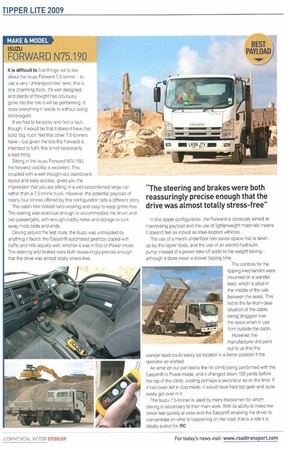MAKE &MODEL
Page 34

If you've noticed an error in this article please click here to report it so we can fix it.
FORWARD N75.190
It is difficult to find things not to like about the isuzu Forward 7.5-turner to use a very 'untransport-like' term, this is one charming truck. It's well designed, and plenty of thought has obviously gone into the role it will be performing. It does everything it needs to without being extravagant.
If we had to be picky and find a fault, though, it would be that it doesn't have that solid 'big truck' feel that other 7.5-tonners have but given the role the Forward is intended to fulfil, this is not necessarily a bad thing.
Sitting in the lsuzu Forward N75.100, the forward visibility is excellent. This, coupled with a well thought-out dashboard layout and easy access, gives you the impression that you are sitting in a well-proportioned large van rather than a 7.5-tonne truck. However, the potential payload of nearly four tonnes offered by this configuration tells a different story.
The cabin trim looked hard-wearing and easy to keep grime-free. The seating was spacious enough to accommodate the driver and two passengers, with enough cubby holes and storage to tuck away most odds and ends.
Driving around the test route, the lsuzu was untroubled by anything it faced. the Easyshift automated gearbox coped with traffic and hills equally well, whether it was in Eco or Power mode, The steering and brakes were both reassuringly precise enough that the drive was almost totally stress-free. In this tipper configuration, the Forward is obviously aimed at maximising payload and the use of lighterweight materials means it doesn't feel as robust as steel-bodied vehicles.
The use of a Harsh underfloor ram saves space that is taken up by the tipper body, and the use of an eiectro-hydraulic pump instead of a power take-off adds to the weight saving although it does mean a slower toping time.
The controls for the tipping mechanism were mounted on a wander lead, which is sited in the middle of the cab between the seats. This led to the far-from-ideal situation of the cable being dragged aver the seats when in use from outside the cabin.
However, the manufacturer did point out to us that the wander lead could easily be located in a better position if the operator so wished.
An error on our part led to the hill climb being performed with the Easyshift in Power mode, and It changed down 100 yards before the top of the climb, costing perhaps a second or so on the time. If it had been left in Eco mode, it would have held top gear and quite easily got over in it.
The lsuzu 7.5-tonner is used by many tradesmen for whom driving is secondary to their main work. With its ability to make the driver feel quickly at ease and the Easyshift enabling the driver to concentrate on what is happening on the road, that is a role it is ideally suited for. RC












































































































































